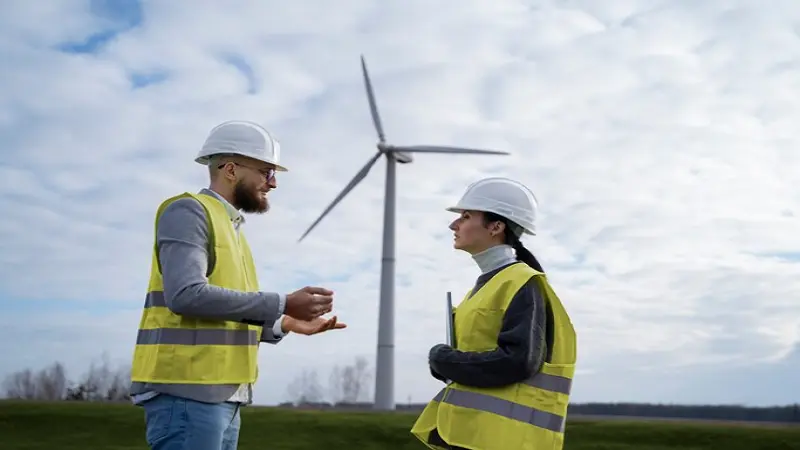In a world increasingly focused on sustainability and self-sufficiency, the term “vwindependent” is gaining momentum. This innovative concept represents a significant shift in how individuals and communities approach energy independence, leveraging the power of wind energy in a more personalized and efficient manner. But what exactly is vwindependent, and why should it matter to you? This article delves into the core of Vwindependent: Revolutionizing Energy Independence with Wind Power, its benefits, and how it is poised to revolutionize our approach to energy.
What is Vwindependent?
The term “vwindependent” is derived from “wind” and “independent,” reflecting a vision where individuals or communities achieve energy self-sufficiency through wind power. It embodies a commitment to harnessing the natural, renewable resource of wind to generate electricity independently of traditional utility grids. This concept is not just about installing wind turbines; it’s about creating a self-sustaining energy ecosystem that empowers users to manage their energy needs autonomously.
The Evolution of Wind Power
To understand Vwindependent: Revolutionizing Energy Independence with Wind Power, it’s helpful to look at the evolution of wind power. Wind energy has been harnessed for centuries, initially to power sailing ships and grind grain. The modern era saw the development of larger wind turbines, capable of generating substantial amounts of electricity. However, these turbines were often part of large-scale commercial projects, and individual consumers had limited access to this technology.
The advent of vwindependent signifies a new chapter. Advances in technology have made small-scale wind turbines more efficient and affordable, enabling homeowners and small businesses to generate their own electricity. Vwindependent represents a shift towards democratizing wind power, making it accessible and practical for everyday use.
Why Vwindependent Matters
1. Environmental Impact
One of the most compelling reasons to consider Vwindependent: Revolutionizing Energy Independence with Wind Power is its environmental benefits. Traditional energy sources, such as coal, oil, and natural gas, contribute significantly to greenhouse gas emissions and climate change. In contrast, wind power is a clean, renewable energy source that produces no emissions. By adopting a vwindependent approach, individuals and communities can significantly reduce their carbon footprint and contribute to a cleaner, healthier environment.
2. Economic Advantages
While the initial investment in wind turbines can be substantial, the long-term economic benefits of vwindependent are considerable. By generating your electricity, you can reduce or eliminate your dependence on the grid, resulting in lower utility bills. In some regions, surplus energy generated from personal wind turbines can be sold back to the grid, providing an additional source of income. Over time, these savings can offset the cost of installation and maintenance, making vwindependent a financially viable option.
3. Energy Security
Energy security is a growing concern, particularly in areas prone to power outages or fluctuations in energy prices. Vwindependent systems provide a level of energy security by ensuring a reliable source of power. In the event of a grid failure or energy crisis, individuals with their wind turbines can continue to power their homes and essential devices. This independence from the grid not only enhances resilience but also reduces vulnerability to external factors that can impact energy supply.
4. Technological Innovation
The rise of vwindependent is closely linked to advancements in wind turbine technology. Modern wind turbines are more efficient, quieter, and aesthetically pleasing than their predecessors. Innovations such as vertical-axis wind turbines and micro-turbines have made it possible to integrate wind energy into residential and small commercial settings more seamlessly. These technological improvements are crucial in making vwindependent a practical and attractive option for a wider audience.
How Vwindependent Works
1. Choosing the Right Wind Turbine
The first step towards achieving vwindependent status is selecting an appropriate wind turbine. Several factors influence this decision, including wind speed, turbine size, and energy needs. Small-scale wind turbines, typically ranging from 1 kW to 10 kW, are suitable for residential use. It’s essential to conduct a wind resource assessment to determine the average wind speed at your location, as this will impact the efficiency and effectiveness of the turbine.
2. Installation and Maintenance
Installing a wind turbine involves several steps, including site assessment, securing permits, and erecting the turbine. Professional installation is recommended to ensure that the turbine is correctly positioned and aligned for optimal performance. Regular maintenance is also crucial to keep the turbine in good working order and maximize its lifespan. Routine checks and servicing help identify and address any issues before they become significant problems.
3. Integration with Existing Systems
A key aspect of Vwindependent: Revolutionizing Energy Independence with Wind Poweris integrating the wind turbine with existing energy systems. This may involve connecting the turbine to a battery storage system, which stores excess energy for use when wind conditions are less favorable. Additionally, some systems are designed to work in conjunction with the grid, allowing users to draw from or contribute to the grid as needed. This hybrid approach ensures a consistent energy supply and enhances the overall efficiency of the system.
4. Monitoring and Management
Effective management of a vwindependent system involves monitoring energy production and consumption. Many modern wind turbines come equipped with monitoring systems that provide real-time data on energy generation and performance. This information allows users to track their energy usage, identify trends, and make adjustments as needed. Advanced management systems can also offer insights into optimizing energy production and reducing costs.
Challenges and Considerations
While vwindependent offers numerous benefits, it’s important to acknowledge and address potential challenges. Some common considerations include:
1. Initial Costs
The upfront cost of purchasing and installing a wind turbine can be a barrier for some individuals. However, financial incentives such as government subsidies, tax credits, and grants can help offset these costs. Additionally, as technology advances and economies of scale improve, the cost of wind turbines is expected to decrease.
2. Site Suitability
Not all locations are ideal for wind energy production. Areas with low or inconsistent wind speeds may not be suitable for wind turbines. Conducting a thorough site assessment is essential to determine the feasibility of a vwindependent system.
3. Regulatory and Permitting Issues
Navigating local regulations and obtaining necessary permits can be a complex process. It’s important to research and comply with all relevant regulations to avoid legal issues and ensure a smooth installation process.
4. Maintenance and Repairs
While wind turbines are generally low-maintenance, they do require regular upkeep to ensure optimal performance. Users should be prepared for occasional repairs and maintenance, which can impact the overall cost of the system.
The Future of Vwindependent
The future of Vwindependent: Revolutionizing Energy Independence with Wind Power is bright, with ongoing advancements in technology and growing awareness of environmental issues driving interest in independent wind energy solutions. As more people recognize the benefits of generating their electricity and reducing their reliance on traditional energy sources, the adoption of vwindependent systems is likely to increase.
1. Technological Advancements
Future innovations in wind turbine design and materials will continue to enhance the efficiency and affordability of vwindependent systems. Emerging technologies such as bladeless turbines and improved energy storage solutions hold promise for making wind power even more accessible and practical.
2. Increased Adoption
As the benefits of vwindependent become more widely known, more individuals and communities will explore this option. Increased adoption will drive further research and development, leading to more effective and user-friendly solutions.
3. Policy and Incentives
Government policies and incentives play a crucial role in supporting the growth of vwindependent systems. Continued advocacy for renewable energy and supportive legislation will help facilitate the widespread adoption of wind power.
Conclusion
Vwindependent: Revolutionizing Energy Independence with Wind Power represents a transformative shift in how we approach energy independence, offering a sustainable, cost-effective, and reliable alternative to traditional energy sources. By harnessing the power of wind, individuals and communities can achieve greater self-sufficiency, reduce their environmental impact, and enhance their energy security. As technology continues to evolve and awareness grows, the potential for vwindependent systems to revolutionize our energy landscape is immense. Embracing this innovative approach can lead to a more sustainable and resilient future, where energy independence is not just a goal but a reality for many.



